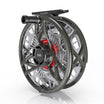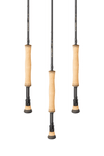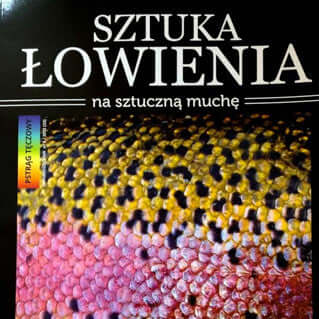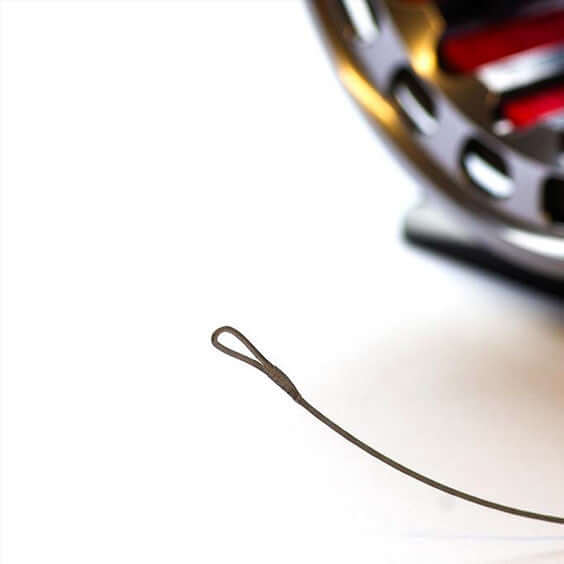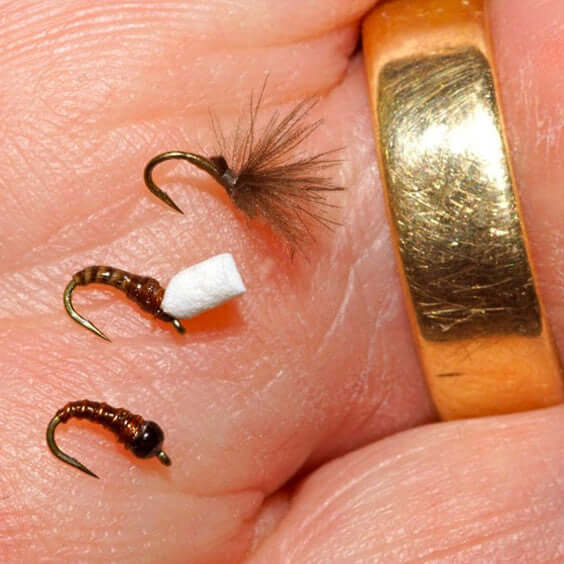Interview in Polish magazine Sztuka Lowienia

REVOLUTION IN THE FLY LINES MARKET? by Paul Fiedorczuk
Nowadays, the development of new technologies is on such a high level that it becomes increasingly difficult for news. Can we come up with something new? From time to time I see a new idea on "Kickstarter" (one of the portals to collect funds for a specific purpose), new fly boxes, new handles in fly rods etc.
However, new improvements end at a fresh reel shape, the new fly line or fly rod blank colour. Nano rods that don't break. Leaders that don't snap. All pretty standard. But what about fly lines that are thinner, float the same and cast straighter? What about if they didn't scare the fish as much?
What about if they were significantly better? Now that would be a genuine improvement. Less than a year ago, I came across just such a start-up. I signed up for the newsletter from this newly created company, which would make super-thin fly lines.
There were delays releasing the new lines but I didn't know that there was only one person behind this company, dealing with all these issues. Tom Bell.

WORLD CHAMPIONSHIP NYMPH
So, I had to see for myself what this revolution was. I got hold of the World Championship Nymph, The Jeremy Lucas Presentation Line and the International. For two months I tested the lines. The World Championship Nymph will interest any competitor using short line nymph techniques in FIPS MOUCHE events. This is the thinnest line approved for use. I don't compete but I use it to the exclusion of anything else for Euro Nymphing styles.
JEREMY LUCAS PRESENTATION LINE
I didn't expect this line to be so thin and still be able to load my rod. I certainly didn't expect it to throw further than 10m. It did both. For me, the biggest advantage is the line's versatility. I fish nymphs with 2m of level tippet and when I want to swap to dries, I just cut the droppers off and use the same tippet. I didn't use a tapered leader with this line because the line is so thin.
Finally, something new on the market and a big breath of fresh air.
INTERVIEW
Now read for yourselves the conversation with Tom Bell, a person consistently following his own path and his own philosophy.
Who are you Mr Tom Bell?
I’m a father of 3 and an obsessive fly fishing tackle designer. I started fishing at 6 and got my first fly rod at 7. I've pretty much not put the fly rod down for 37 years. 8 years ago I took up salmon fishing seriously which ended with an advanced certificate with AAPGAI. I decided being an instructor didn’t suit me and I've been following my own path since then.
First time I heard about you and Sunray was about a year ago. Please tell us when you founded Sunray and why.
When I became an instructor, I did what everyone does, set up a guiding business. Sunray started life as Sunray Adventures. I didn’t like selling fishing holidays because I wasn’t good at it and I'd always made my own fly lines at home by welding. That was where my real interest lay.
When I was training to be an instructor I needed a 65' Spey line at 52g that would dead line roll cast well at 56'. That line didn't exist so I welded one out of 16 other fly lines.
I’d approached Northern Sports to make that spey line for me and they sent me a single hand sample which was on mono. After 3 casts of the line I called the factory and placed an order. From that point on I made fly lines. I didn't sell trips or teach.
Do Northern Sports make your lines then?
Yes.
What level of input do you have over the whole manufacturing process.
As far as I know, I’m the only OEM client who actually works on the factory floor making the lines with the guys. I don’t operate the oven machines but I oversee every part of the process. I research and define every aspect of the coating chemistry. I choose the cores and the chemicals. They are specific to Sunray.
I see the entire process through from initial concept, to manufacturing, to packaging. Sometimes I enter the factory with a taper. I design it, oversee it’s manufacture, measure, weigh and test it, then coil it, label it, loop it and package it. All in one day. I have a unique relationship with the factory. I owe them a lot.

What about the business side of things?
I designed every aspect of the business’s identity. The only thing I didn’t do was the logo. I designed the website, packaging, products and social media pages. I’m the guy you speak to when you call, email or meet at a show. I’m the guy who will post your line and I’m the guy who will fix anything you need afterwards. The business is me. There are no shareholders or investors. I don't even have an overdraft facility.
I've built the company to be totally self reliant. I like it that way. I don't owe anyone any explanations apart from customers. I can make a decision on a product or an opportunity instantly. I don’t have to have a meeting or send an email to anyone. It makes the process very quick, efficient and economic.
Is it hard to make fly fishing tackle these days? What obstacles did you have to cross?
I've never made tackle before now so I can't say what it's like compared to say 10 years ago. I do know that fly line factories are very busy right now, so getting your lines made takes more than just big orders. In terms of design, the tapers for the International lines were very challenging.
The International line. Is the Arctic Silver Innovation ‘Micro Diameter’ line the same line?
No. The only things that my lines share with the ASI "Micro Diameter' lines are the tapers and some running line coatings. Their head coatings are not my design. The lubricity compound is, but the weight and colour is not.
A Sunray International line is generally at least 1g heavier for the same taper, sometimes 2g. When you buy an ASI line you may have to buy one rating heavier than they list, because of their coatings. It’s something we disagreed about and ultimately it’s the moment when I decided I couldn’t continue working with them. If a line is thin but you have to use a rating higher, it’s not thin anymore is it.
Also, I was verbal about how I didn’t agree with the term ‘Micro Diameter.’ It suggests the lines are dramatically thinner than normal which they aren’t. I even struggled with calling mine Low Diameter.
What about the taper then?
I had already made the International taper for my own use but Arctic Silver Innovations wanted to buy the rights to use them on their rods and claim they co-designed them. So I tweaked 4 separate tapers, based on the International to fit their range of 4 free flex rods. That was challenging because the rods allow the blank to move in the handle. The lower the rod rating the more creep the handle imparts.
Basically, you move your hand but the rod tip is delayed because the butt is still travelling in the handle. Casters talk about a ‘hook up’ point, where you can feel the point the line bites and loads the rod. That point is later on a free flex rod, because they creep forward slightly on the lower models which also have softer blanks. I had to compensate for that when I designed their lines. It was a great a learning ground for me in terms of how a rod interacts with a line and how to influence a rods action. In this case, I had to speed them up.

Ok, what about your ‘Micro Thin’ lines. How did they come about?
I was working with Northern Sports already when they sent me a sample of a mono core line. That line was also sent to Snowbee who developed it into the Thistledown.
Are your Micro Thin lines the same as Snowbee Thistledowns?
Absolutely not. The Thistledown is a great product but a Sunray Micro Thin line shares only 1 out of many possible components with the Snowbee line. We both use mono, that's it. Our Jeremy Lucas Presentation Dry Fly line is 0.95mm in it's thickest weight. From recollection, a Thistledown is 1.2-1.3mm. We developed coatings specifically for use on our mono cores that are entirely different to Snowbee's. Our coatings feature copolymer coatings that are protected by the factory.
The coatings were so successful we moved them over to braid also, which created our ‘Low Diameter’ lines. So we use the same polymer chemistry on our Micro Thin lines as we do on our Low Diameter range. Our Low Diameter lines are built on a braided core though.
I did a lot of work measuring competitors lines and comparing my own lines to the diameters of silk lines. I came to the conclusion I could only realistically call my braided core lines, Low Diameter.
My Low Diameter lines were only 5-10% thinner than regular PVC lines. Less, in some cases. My Micro Thin lines are different. They are on mono and they are considerably thinner. 30% in some cases. So I split my lines into 2 categories. Low Diameter and Micro Thin.
Who was the first to make thin lines?
That’s easy. The silk line guys. In 1880, Eaton and Deller made the first solid braided silk fly lines with a pure boiled linseed oil dressing. It was applied under pressure by an air-pump. It helped the thin lines float. Modern attempts to recreate silk lines started with Cortland. Their ’Sylk’ line was a reference back to silk. In reality it shared only colour and taper with them, not their diameters.
In my lifetime I regard some of the shooting heads made by Airflo for Guideline as being ‘low diameter.’ Very good lines indeed. The Ballistic Vector #10 spey line is a low diameter line, but it doesn’t float as well as it could in my opinion. That’s one of the drawbacks of making something thinner. The LTS Across shooting head was described as being ‘low float.’ Another great line, although the taper was the key performing factor in my opinion, not the specific gravity.
I loved Loop’s tapers and the Carron Jet Stream’s. Through my life as a fly caster and an instructor, I’ve obviously had favourite lines. All those points of reference channel through into my designs, it’s how creative processes work. What I do is take the behaviour of all my favourite lines and work them into new designs, new polymer compounds and new tapers.
But absolutely, these brands have flirted with designs that have featured high density, low diameter coatings as one of their design elements before me. I’m not claiming to have invented the wheel. Sunray is a brand that seeks to make really great fly lines. I use every point of reference to do that. I've been casting fly lines 39 years. I have a lot of points of reference.
You talk about lines being low float and high density. Onto the big question, how do you make your Micro Thin lines float so well?
Ok, I regard this question as the most asked and most debated. I’ve purposefully not responded to internet discussions on this topic until I knew what I can say and can’t say. It’s still difficult knowing how to speak about it. But let’s start here, silk lines. Silk has a specific gravity around 1.33g/cm3 which means it sinks if untreated. Water is 1.0 so anything above that figure, if submerged will sink.
That is unless you use water tension to prevent it breaking the surface in the first place. This is the point that I see most people have missed in internet forums. Also the fact that most floating lines have too many microspheres in them already, in my opinion. This is the most interesting part for me. The power of marketing. People believe that fly lines must have been optimised right to the ceiling of possibility already.
They haven't. In fact, before I even started learning about polymer chemistry and basic physics, the industry had left 15% diameter gains on the table for me, which I saw and jumped on. For 40 years fly lines have used high percentages of microspheres to make fly lines buoyant.
So the answer to 'how you do reduce the diameter of a fly line and still make it float? It's impossible.' is 'by not using high percentages of high particle size microspheres.'
Or the short answer is. 'They were already thicker than they needed to be to float! The market just didn't know it. We've been casting fly lines that have been thicker than they needed to be for 40 years.'
The irony is that when I made them thinner, people accused my innovation of being marketing hype, when it was 40 years of hype that allowed me to make an honest 30% improvement!
What is even more interesting is that the silk line guys have quietly been enjoying this diameter reduction unaffected by the trend for brightly coloured, thick plastic fly lines that crack for years. Silk lines are heavier than water. They float. My question is this? Why has the industry ignored that fact for 40 years?
Let’s look at a modern floating fly line. Typically their specific gravity will be between 0.80g/cm3 and 0.90g/cm3. A Sunray Micro Thin line will have a specific gravity of 1.1g/cm3, but it floats. The coating features a hydrophobic compound which repels water. In just the same way a silk line, when dressed, ’swam’ on the water’s surface, so does a Sunray Micro Thin line.
PVC and silk has always shared one common enemy though, dry, cracked coatings that wick water. PVC fly lines can crack because of the excessive microsphere filler in them, amongst other reasons. The excessive use of silicone too. It migrates and evaporates, leaving a dry coating. You had to constantly dry and redress silk lines, because their hydrophobic coatings would also evaporate and lose efficacy.

Ours don’t. A Sunray Micro Thin line is really very close, in terms of performance, to that of silk lines. But you don’t have to dry and redress their coatings. They are permanent. That is one of the major developments that happened to the lines sometime in 2015. I developed a co polymer bond of chemicals that creates a permanent dry lubricant that never evaporates. It's permanently super hydrophobic.
In summary, making the specific gravity of our Micro Thin fly lines close to that of water means I can lower the diameter by up to 30%. Using water tension and super hydrophobicity means that I can create the forces required to float or ‘swim’ the line on top of the water. Just like the silk lines did. Modern polymers and high grade microspheres mean the lines float well and never dry out.
Our Low Diameter lines are different. An International, Masters Spey or Scandi for instance, they are on a braided core and they are Low Diameter. They are only 5-10% thinner than regular lines but also feature super hydrophobic coatings which make them swim higher than than their sg suggests. They use a braided core which is hollow, contains air and thus reduces the sg to around 0.97. So our low diameter lines have what’s called ‘positive buoyancy.’ If they break the water's surface, which happens to all floating lines sometimes because of their weight, they will return to the surface. I just don't put as many microspheres in as everyone else.
There’s a misunderstanding about tapers too I think. Companies are using mass to overcome drag. Lines are too thick. They have to be. That's why lines have got heavier and heavier. Yes, because rods have got stiffer but also because lines have got fatter. We've been on a hamster wheel just getting stiffer rods and fatter fly lines. I just got off the hamster wheel and took a look at what was going on from another perspective.
Formula 1 cars have very small engines but highly optimised engines and aerodynamics. My lines are the same, they require very little power to cast because the mechanics of the polymers are so efficient. They have better aerodynamics by being thinner in diameter but also better polymers in terms of energy management.
Basically, they are tuned fly lines that have exploited the lack of development in PVC lines over the last 40 years.
Thanks for that. Is diameter the main feature that makes the lines perform?
Not really no. I used to think it was. I now think differently. Diameter helps with the delicacy of the presentation the most. In terms of flight, I now think it’s coating. That’s what I mean when I say ‘energy management in polymers.’
Why?
A fly line is a wired projectile. Like a harpoon or even a spinner on a fixed spool. A projectile is thrown towards a target but remains attached to it’s source. However, there are 2 forces involved in fly line flight. The rod load (potential energy) and the energy flow in the line (kinetic energy.) That’s why a fly line is unique. It’s dynamic, meaning it changes form and its constantly moving.
When I design a line I think about making a wired projectile. It just so happens to be great if you use it as a fly fishing line! So I need 2 things, weight to load potential energy in the rod, and density to lower the impedance of energy as it travels through the coating. This low impedance of energy speeds the line up. Just like you have ‘fast’ or ‘slow’ rods, I make ‘fast’ fly lines. It’s a characteristic you notice immediately.
They fly far, fast and straight. That’s because energy is allowed to flow freely though the coating. That has the most effect on stability and distance. Diameter does affect stability and distance but has more affect on presentation.
How do you create ‘fast’ fly lines?
I’m not telling you!
Ha ha. Understood. Thanks anyway. Ok then, what do energy efficient coatings mean in the real world?
Having a fast coating means you don’t need that fast rod’s potential energy anymore. That’s one of the joys. I’m a fly fisher. The older I get, the slower I want my gear. I speak to more and more people nowadays that want their gear to have feeling. But they still want the dramatic line speed and the hero cast.
There has been a resurgence in fibreglass recently which is part of the lean towards fuller flexing rods and lighter line fishing. I design coatings and tapers that increase the tip speed of cane / bamboo and fibreglass rods.
We tested them recently with a very expensive collection of non graphite rods and matching reels. Over 4 days in Cannes, we cast every taper imaginable. The results were the Cane & Glass Streamer fly lines. The tapers reduce the friction in the small guides. The running line is very thin to remove weight from the guides. Double taper lines keep too much thick line in the guides and create weight / friction.
What we found is that a regular aftma weight Low Diameter line was typically 1-1.5 times too heavy for non graphite rods, so we have adjusted the WF profiles to suit them.
My coatings make fishing lighter gear possible without losing high line speed and dramatic distance. You used to need stiff sticks to throw far an fast. Not now. You can fish a line weight lighter, a rod rating lighter, a reel size lighter and a thinner tippet. You hook more fish and land more fish because the gear you are using has more shock absorbency.
But to answer your question. It means you catch more fish and have more fun in the real world!
I know you are the first to admit that you had problems with the coating in the early stages.
Absolutely, that’s true. On the World Championship Nymph and Jeremy Lucas Presentation Line (Micro Thin range) we had some lines returned because the coating had peeled off. We fixed the issue with a new coating which bonds to the core better. It also prevents wear on the surface. But the early days were embarrassing. I had to apologise profusely and hopefully all customers who experienced the problem are satisfied with their replacement, and in many cases, discount codes for future purchases.
I’ve heard people question the cost. Why are the lines premium price?
When you are making such a thin line the tolerances become so tight that the amount of waste line produced is more than the retail ready versions. Making the Micro Thin range was, and still can be, very wasteful. It’s also very difficult getting them made. The factory is busy running low waste, high sales, high volume braided core products for big brands.
Getting even 50 Micro Thin fly lines off the machines can be time consuming and labour intensive. And I mean really labour intensive! 50-60% more waste and labour involved than a regular line. All because the tolerances are so finite. Even without waste and supply issues the time it takes to develop either a Micro Thin or Low Diameter line is great. It involves me being at the factory and it involves lots of time tying up valuable machine time.
At the end of some days, we even have to throw the days work away and start afresh. That’s not the case with tried and tested manufacturing processes used to make big brand lines. Also, I think they are worth it. Simple as that. I’d buy them instead of a Rio or Cortland or Guideline. So they cost the same.
I see the colours on some lines have changed. Why?
I get a certain amount of time in the factory to make retail ready lines and do the R&D. That means trialling certain polymers in retail products, thus colour changes. The colour change tells me which polymer is in that coating.
Does that mean that some lines are better than others?
Absolutely not. It means that the lines that have been sold have performed so highly in our tests that they have gone to retail. For every running line colour change you have seen, there has been 10 more that ended up in the bin. Also, in the early days I had to share the running line colours with Arctic Silver Innovations who wanted 4 different colours. So I had to also. Not any more.
What do you mean?
We have settled on 3 mixes. Recently we threw away all mixes that have led to this point. Now you will see a continuity of colours through entire ranges. So a single hand line may also have the same colour head as a double hand line.
The dark grey is a little hard to see. Have you changed that?
We will have changed it soon. We have developed a dark magenta / burnt umber coating that you can physically see more easily, but it doesn’t scare fish. That was the great thing about the grey lines. They are so stealthy. The new pigments retain that but they can still be seen by the angler.
What was the deal with Christer Sjoberg and Solid Adventures?
Christer asked me to make the ultimate line for their Lodge in Patagonia. The fishing on the Rio Gallegos needs great delicacy one minute and the ability to cut into 80kph winds the next. Christer sent the specs for a shooting head and I made it using my low diameter technology. We fished it last March in Argentina for 6 days. The results were even better than expected.
The line was nicknamed the Low Runner because it reminded me of a sea snake. In a big wave you just see this ochre coloured section of floating line dug into the surface, in full tension, snaking through the wild wind and waves, still fishing. It was great.
All the guests at the lodge used them. The technology on that line will feature in all our low diameter lines in some form.

How did you get to know Jeremy Lucas?
Email! That’s the great thing about modern life. You can easily find people and contact them. I knew about Jeremy’s leader. I bought a couple of his books and read them. After that I knew I had to contact Jeremy. Straight away he understood the benefits of our Micro Thin lines. After sending a World Championship Nymph sample he replied with a very lengthy, excited email. He still does! That’s the great thing about Jeremy. His enthusiasm and passion is so focused. I love it. Even when he doesn’t agree with something I’ve done and he tells me, I still love him! Because he’s so passionate and usually right!
The line design was very simple. The brief was to make a fly line that presented like a French leader but could be cast by an intermediate angler with a 10’ rod. We nailed it in one sample. In fact, Jeremy still uses that same sample. Jeremy was resolute about not profiting from the arrangement. An amazing quality. Jeremy wants to enjoy his fishing, protecting his allegiances as much as he wants to protect his environment. He’s a great friend and an inspiration.
When I fished with Jeremy on the San I saw what he had been trying to explain to me, that my lines are a pivotal moment in fly line design. Jeremy’s ability to learn individual fish, sometimes multiple fish in a short area, is very specific and having a line that can pick off each fish without spooking the rest, was something to behold. I knew my lines were stealthy. This was almost unfair!
What about a pro team? I don’t see the usual posts on facebook from guides calling themselves Sunray Pro Staff!
I don’t have a Pro team. I don’t like the term. To me, it's sponsored marketing. The minute you pay for someone to represent your brand, the advice you get from them is compromised. Customers know that. Why pretend they don't?
People use my gear because they want to, not because I pay them.
What about the future for Sunray?
More lines, rods and reels. We are making a British engineered large arbour, hubless click check fly reel specifically for micro thin fly lines. We have the British made PL2, PL3 10’ 2 and 3 weight nymph and dry rods in production, a 12’9 6 piece 7 and 8 weight spey rod, 9’ #5 & #6 rods and some more single handers.
How do you see the fly line market in about 10 years?
Honestly, I see the way they are marketed to change. We are honest. We engage with our audience in a modern way. We don’t do sales. We do R&D and let sales take care of themselves. Fly fishing is changing. We see ourselves as part of that change in terms of tackle and how it’s marketed. We do hardcore R&D and just live in the moment, the sales and marketing takes care of itself.
Thank you for kind conversation, hope we could fish together in the future.
Likewise Pawel.
Further reading:
Silk fly lines. Wolfram Schott 2007.







